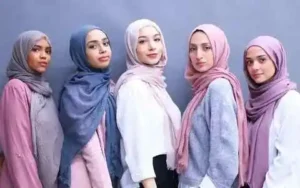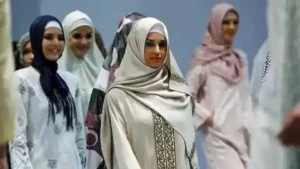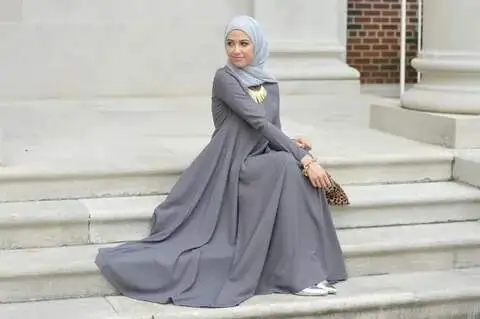Islamic fashion for women has come a long way, evolving from traditional attire to a global fashion trend that balances modesty with contemporary style. Today, it’s not just about covering up—it’s about expressing identity, culture, and personal taste. With fashion houses and designers catering to this ever-growing market, modest fashion is no longer limited to one corner of the world.
But what does Islamic fashion for women really mean? How has it evolved, and why is it capturing the attention of the global fashion scene? Let’s break it down.

What is Islamic Fashion for Women?
At its core, Islamic fashion for women is about dressing modestly according to Islamic principles. This typically involves wearing loose-fitting clothes that cover the body, such as abayas, hijabs, and long dresses. But modesty doesn’t mean compromising on style. Over the years, Islamic fashion has blended cultural heritage with modern trends, creating a diverse array of fashion choices for Muslim women.
From the traditional black abayas of the Middle East to the vibrant, pattern-rich dresses seen in countries like Indonesia and Pakistan, Islamic fashion is deeply influenced by regional styles, fabrics, and tastes. What’s common across the board, however, is the emphasis on dignity, modesty, and comfort, allowing women to express their identity in a way that aligns with their faith.
The Evolution of Islamic Fashion
Islamic fashion for women has evolved significantly over the years. Historically, women wore simple, often plain garments that served the purpose of modesty. But as the world became more globalized and the fashion industry expanded, the demand for more variety in modest clothing grew. Muslim women wanted to reflect their personal style while still adhering to religious guidelines.
This gave rise to what is now called “modest fashion,” a movement that transcends religious boundaries. Designers from all over the world have recognized this shift, creating collections that offer both modesty and elegance. Muslim fashion bloggers and influencers have also played a significant role in redefining Islamic fashion, showing how modesty can be stylish, chic, and modern.
Modern Trends in Islamic Fashion for Women
- The Abaya Reimagined
The abaya, a traditional long cloak worn in the Middle East, has undergone a massive transformation in recent years. No longer just a plain black robe, abayas now come in various colors, fabrics, and designs, incorporating embroidery, lace, and even sequins. Modern abayas are worn not only for religious reasons but also as a fashion statement. - Hijab as a Fashion Accessory
The hijab, a headscarf worn by many Muslim women, has also become a key fashion piece. With endless fabrics, colors, and styles available, women can now choose a hijab that complements their outfit, mood, or occasion. Hijab tutorials on social media platforms have further popularized various creative ways of styling it, making the hijab both practical and fashionable. - Maxi Dresses and Gowns
Maxi dresses and gowns have become incredibly popular in Islamic fashion for women. These long, flowing dresses offer full coverage while allowing for creativity in fabric choice, cuts, and prints. Whether it’s a casual day out or a formal event, maxi dresses are a go-to option for modest fashion lovers. - Cultural Influence
Islamic fashion isn’t limited to the Middle East. In fact, countries like Turkey, Malaysia, and even Western nations like the U.S. are contributing to the rise of modest fashion. From Turkish kaftans to African-inspired modest dresses, Islamic fashion is as diverse as the cultures it stems from.
Why Islamic Fashion is Gaining Popularity in the U.S.
In recent years, Islamic fashion for women has seen a massive rise in popularity in the U.S. This can be attributed to a number of reasons:
- Inclusivity: More fashion brands are recognizing the need for inclusivity. They’re offering collections that cater to a wide range of customers, including those who prefer modest fashion.
- Sustainability: With the growing trend toward sustainable fashion, many women are turning to modest fashion. Loose-fitting, long-lasting garments like abayas and maxi dresses often require less frequent replacement than trendier, fast-fashion items.
- Celebrity Influence: Celebrities like Halima Aden, a hijab-wearing model, have made Islamic fashion more visible on the global stage, breaking barriers in the fashion industry and promoting modesty as a valid style choice.

FAQs About Islamic Fashion for Women
1. What makes a garment “Islamic” in fashion?
Islamic fashion prioritizes modesty, covering the body according to religious guidelines. However, this can vary based on personal preferences and cultural practices.
2. Can Islamic fashion be trendy?
Absolutely! Islamic fashion for women has embraced trends while maintaining modesty. From stylish hijabs to elegant abayas, modern designs allow women to stay fashionable without compromising their values.
3. Do I have to wear black to dress modestly?
No. While black is a traditional color in some cultures, Islamic fashion for women today offers a wide range of colors, fabrics, and designs. You can dress modestly and still express your personal style with different shades and patterns.
4. Is modest fashion only for Muslim women?
No. While Islamic fashion for women is rooted in religious guidelines, modest fashion has become a global trend, attracting women from various cultural and religious backgrounds.
Islamic Fashion in the Digital Age
With the rise of e-commerce and social media, modest fashion has found a global audience. Muslim women can now shop for modest clothing from anywhere in the world, and influencers and fashion bloggers are making Islamic fashion for women more accessible. Hashtags like #ModestFashion and #HijabStyle have millions of posts, showcasing the versatility and creativity of women who want to dress modestly but fashionably.
How to Embrace Islamic Fashion
If you’re new to Islamic fashion for women or modest fashion in general, here are some tips to get started:
- Start with basics: A good-quality abaya, hijab, and maxi dress are versatile pieces you can wear for many occasions.
- Mix modern with modest: Pair a trendy jacket with a simple maxi dress, or layer a fashionable blouse over an abaya for a chic, modest look.
- Accessorize: Don’t forget about accessories! A stylish bag, jewelry, or belt can enhance your outfit without taking away from its modesty.
Conclusion
Islamic fashion for women is more than just a trend—it’s a powerful movement blending tradition, style, and personal identity. With the growth of the modest fashion industry, women can now choose from a wide variety of garments that allow them to express their faith and individuality without sacrificing style.
In the U.S. and around the world, Islamic fashion is becoming a symbol of empowerment and self-expression, making it a thriving part of the global fashion landscape. Whether you’re looking to add modest pieces to your wardrobe or fully embrace Islamic fashion, the possibilities are endless, and the result is always stylish.
Read more: womenfashionwear.site

